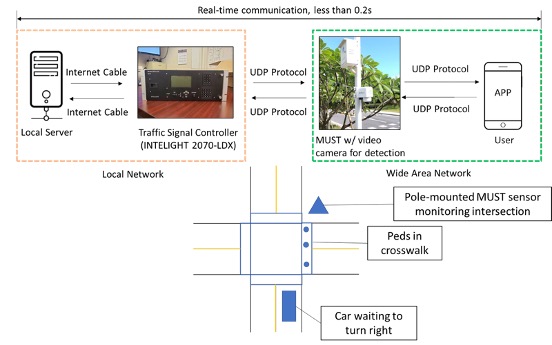Traffic safety is consistently a top priority for all levels of transportation agencies. However,the majority of research focuses on vehicular safety and often ignores active mode users, who are particularly vulnerable in collisions. While the total number of traffic-related fatalities declined between 2017 and 2018, the numbers of pedestrian and cyclist fatalities both increased (NHTSA, 2019).
In order to complement the three US DOT Connected Vehicle (CV) pilot programs, i.e., the New York City DOT Pilot (NYCDOT Pilot), the Tampa-Hillsborough Expressway Authority Pilot (THEA Pilot), and the Wyoming DOT Pilot (WYDOT Pilot), the National Operations Center of Excellence (NOCoE) initiated a program called the Signal Phasing and Timing (SPaT) Challenge to encourage the adoption/study of CV applications across the country. Under this program, DOTs in all 50 states were encouraged to equip at least 20 signalized intersections with radio equipment capable of broadcasting SPaT information and other CV messages. While the benefits for vehicular users are obvious, the initiative has largely ignored pedestrians and other active mode users. To bridge this gap, the STAR Lab parners with WSDOT to develop an application (app) for use on mobile devices. This app can (1) present SPaT data to active road users and (2) allow these users to actuate pedestrian crossing signals at intersections via the app, i.e., the app has a virtual "pushbutton". Besides the app development, another goal is to develop a communication channel between the users' mobile phones/apps and the traffic signal controller. This is achievede by the MUST sensor, which is able to communicate with the phone via WiFI and to communicate with the signal controller via the UDP protocol.There are 10 signalized intersections along WA-522 included in the test plan.

Figure 1. Proposed SPaT framework with MUST and mobile apps for active users' safer street-scrossing).
Related Publication
Yang, H. F., Ling, Y., Kopca, C., Ricord, S., & Wang, Y. (2022). Cooperative traffic signal assistance system for non-motorized users and disabilities empowered by computer vision and edge artificial intelligence. Transportation Research Part C: Emerging Technologies, 145, 103896.
